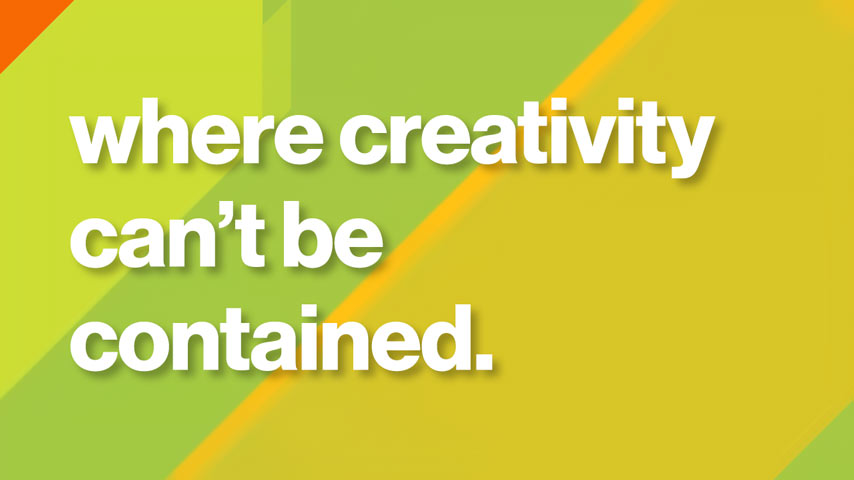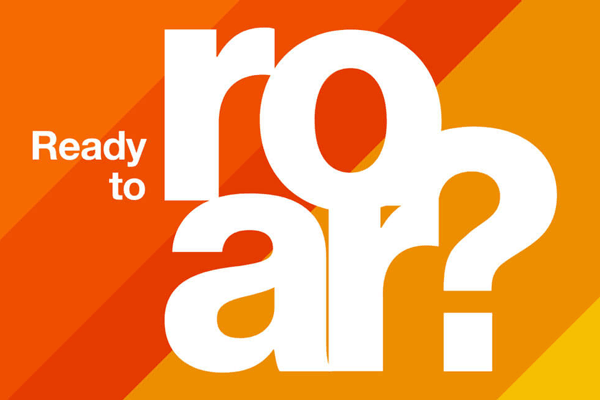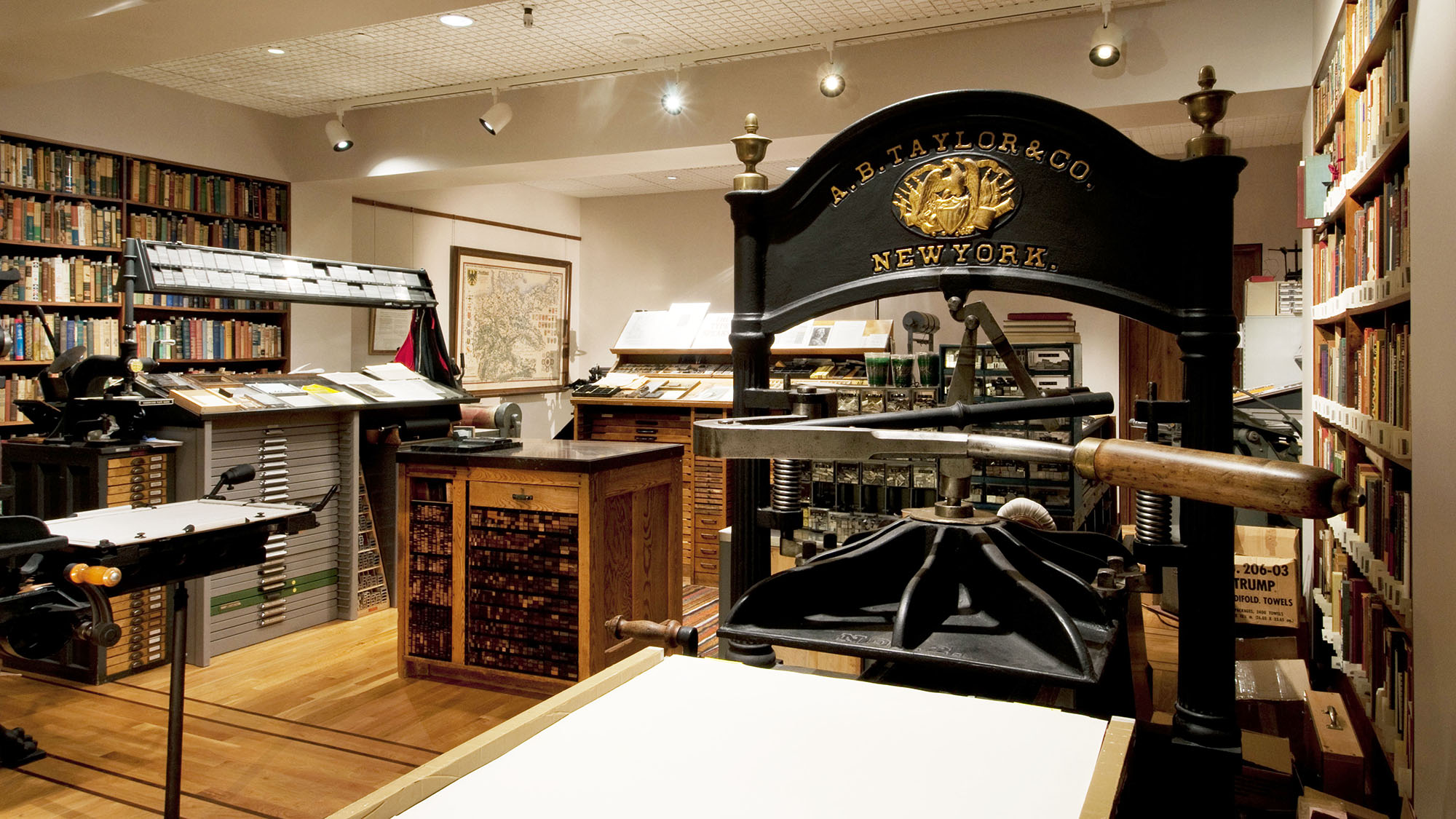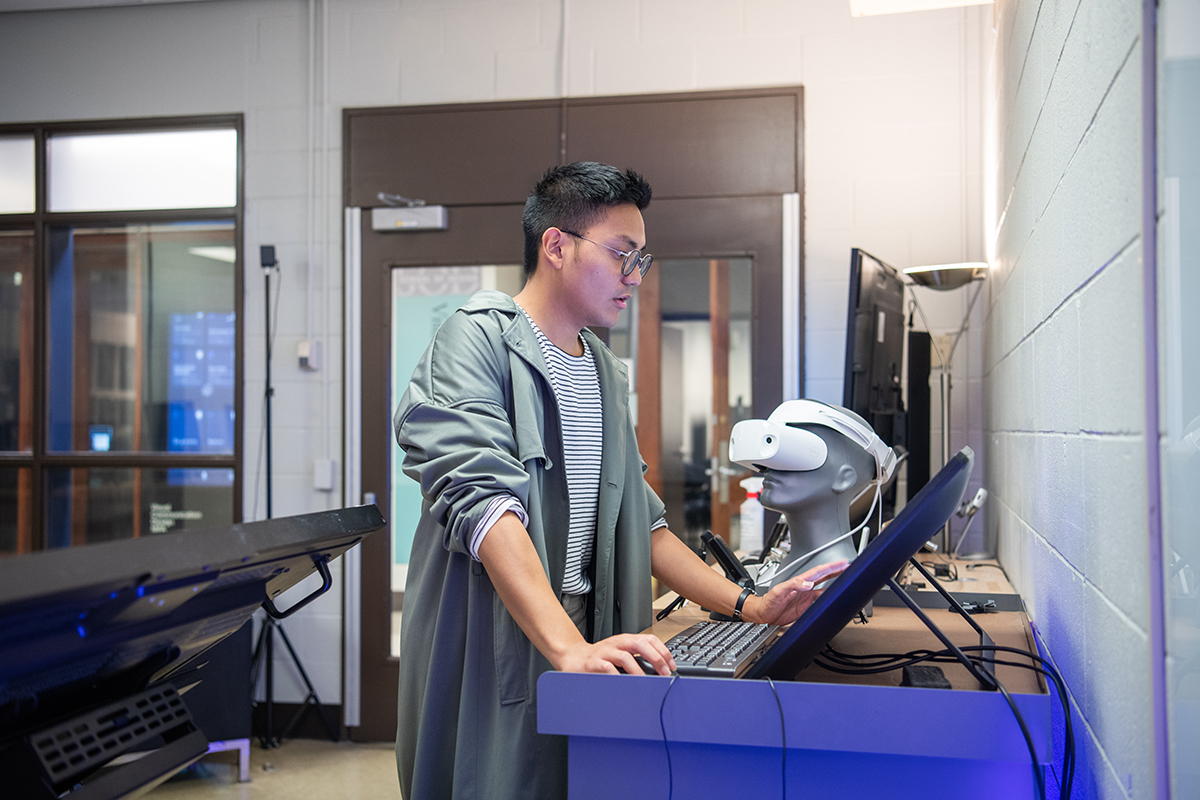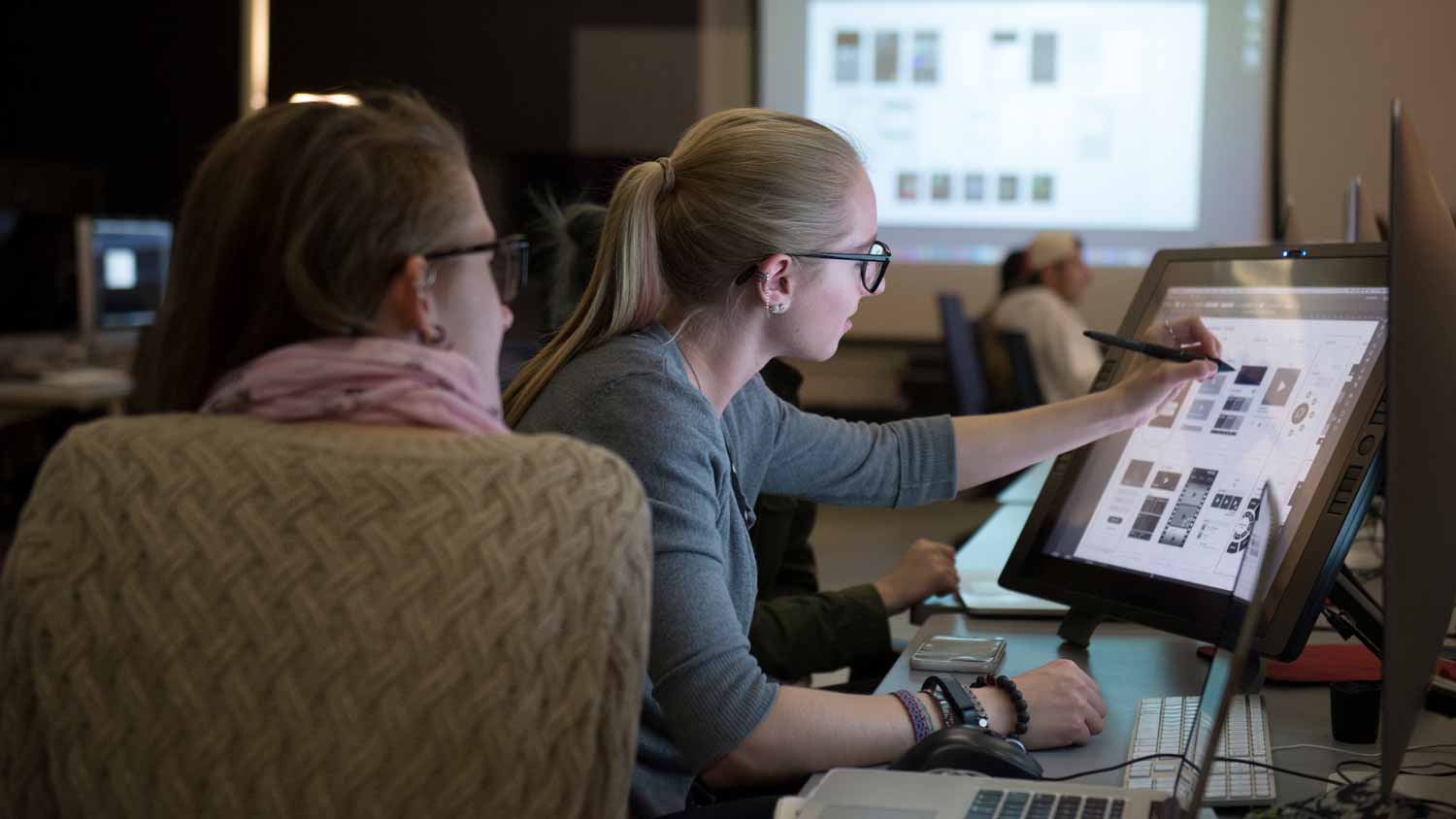New Media Design Bachelor of Fine Arts Degree
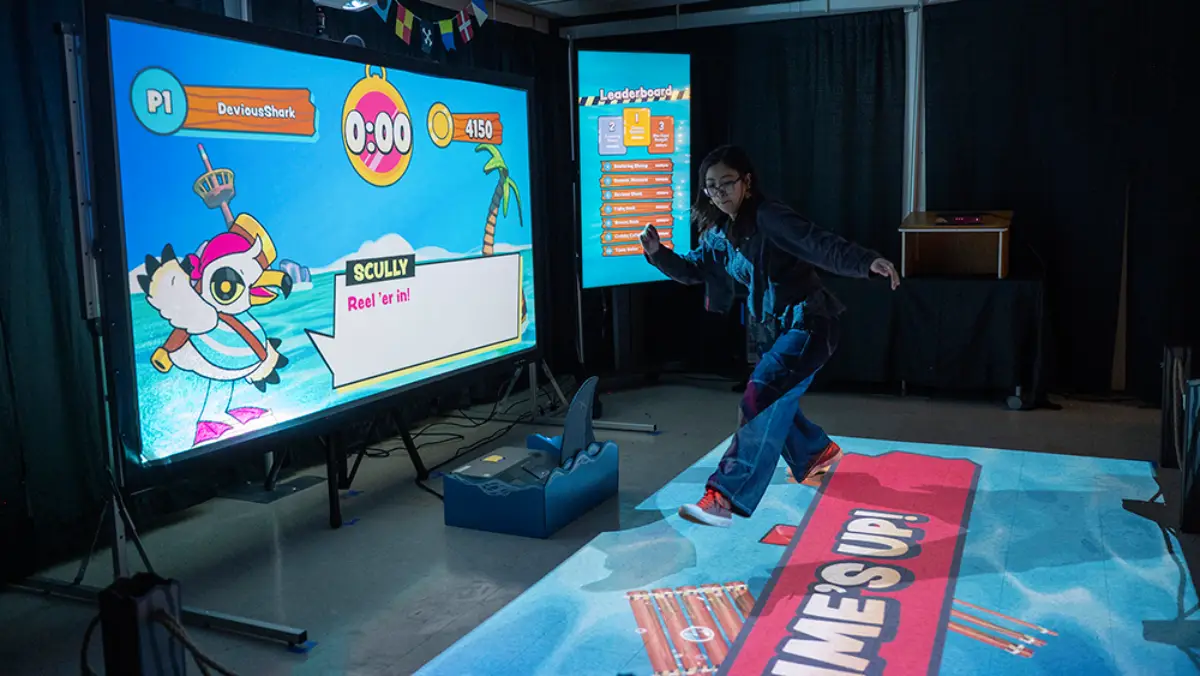
New Media Design
Bachelor of Fine Arts Degree
- RIT /
- Rochester Institute of Technology /
- Academics /
- New Media Design BFA
Overview for New Media Design BFA
Why Pursue a New Media Design Major at RIT?
An RIT New Economy Major: Stay ahead of the curve with digital media design in this creative program built for our tech-driven world, preparing you to take advantage of today’s multidisciplinary marketplace.- Design the Future for Digital Products: Become a leading creator with UI/UX, interactive, motion graphics, and visual design expertise through a unique program that blends creative and technical skills.
Endless Career Possibilities: With hands-on experience, you’ll learn how to design UI and UX solutions for everything from mobile apps to immersive interactive experiences to digital products, preparing you to work for top tech innovators like Amazon, Meta, Microsoft, Google, and leading creative agencies.
Real-World Interactive Media Design: Tackle real client challenges in AR, games, mobile, and screen-based installation projects for industry partners.
Collaborate Across Disciplines: Work and learn with peers in an interdisciplinary curriculum that blends visual design, coding, AI, motion, creativity, and screen-based technology.
STEM-OPT Visa Eligible: The STEM Optional Practical Training (OPT) program allows full-time, on-campus international students on an F-1 student visa to stay and work in the U.S. for up to three years after graduation.
What is New Media Design?
Interactive screens and displays are part of nearly every aspect of your life. New media design is central to creating these dynamic and interactive experiences. New media designers shape how we experience information, entertainment, and human connection across every digital screen and app, from smartphones and wearables to car dashboards, health care devices, and smart home devices. Our new media degree prepares you to push the boundaries of visual communication by integrating innovative technology, motion graphics, 3D, and design to craft tomorrow's digital landscape. Get ready to become a leading interaction designer, digital product designer, UI and UX designer, immersive designer, or a motion graphics designer and pursue in-demand careers with industry giants like Google, Apple, Instagram, Spotify, Amazon, Microsoft, Disney, and top creative agencies.
RIT’s New Media Design Major
New media is more than just the design of graphics for interfaces or user experiences; it's an ever-evolving ecosystem of skills, knowledge, technologies, and creativity that shapes how we communicate, learn, and connect in the digital age.
Pursuing a new media degree prepares you to master the full range of skills and knowledge required to create transformational digital designs. You'll build expertise in visual design, user experience, interaction design, creative coding, and motion graphics. These essential skills are needed to create captivating experiences that define the future of digital engagement. As technology evolves, new media designers stand at the intersection of creativity and innovation, ready to shape the next generation of digital interactions.
Our program prepares you to be an agile new media designer, ready to adapt to the ever-changing digital landscape. From emerging social platforms and new streaming technologies to breakthroughs in spatial computing and AI, the field is constantly evolving. You'll master timeless design principles and cutting-edge tools, equipping you to innovate and thrive in whatever comes next.
New Media Prepares You for a Creative Future
New media design isn’t yesterday’s design degree. It is an interactive exploration in creativity, technology, and visual design for our interactive world. You will gain the skills and knowledge needed to transform your innovative ideas into impactful, real-world projects for the apps and screens around you. You will learn to design innovative designs, motion graphics, and user interfaces for mobile apps to fully immersive digital environments through a dynamic curriculum that covers:
- Advanced Visual Design
- Digital Product Design
- Typographic Design
- User Interface Design (UI)
- User Experience Design (UX)
- Interactive Design
- Dynamic Information Design
- Animation
- 3D Modeling
- Motion Graphics
- Prototype Building
- Projection and Large-screen Design
- Creative Coding
New Media Design Courses
Collaborative Learning for Digital Products
In today’s digital world, teamwork and collaboration are essential. While studying new media design you’ll learn, work, and grow alongside students from RIT’s new media interactive development major, a BS degree focused on advanced programming and applied development for interactive digital products. These coding experts bring digital designs to life, and their collaboration is key to the success of every digital experience we enjoy.
Both degree programs share foundational courses in programming and design, ensuring you develop the complementary skills needed to excel together in the industry. In addition, new media design students can enhance their technical expertise by taking programming courses or pursuing a minor in a variety of areas, including:
- Mobile development and alternative interfaces
- Website design and implementation
- Physical/wearable computing
- Game design and development
- Design and media production
- AR/VR/MR Experiences
- Interactive audio
- And more
Your fourth year concludes with a capstone project where you’ll team up with new media interactive development students to solve real digital challenges through innovative, experimental solutions. These projects address genuine industry problems and involve partnerships with leading organizations such as Xerox, The Strong National Museum of Play, Instrument, Constellation Brands, Forbes, Rochester Regional Health, and the Rock & Roll Hall of Fame. Through these hands-on, team-based experiences, you’ll graduate not only with a robust portfolio that showcases your creative design abilities and refined soft skills but also with real-world experience that makes you highly attractive to future employers. View samples of new media team projects to see what our teams have created.
Study Abroad
Expand your creative perspective by studying new media design at one of RIT’s global campuses. With fully matched courses, you can immerse yourself in a new culture while staying on track with your new media degree.
-
RIT Croatia: Study in the heart of Europe’s emerging tech and design scene. Gain international insights, collaborate with global peers, and explore Croatia’s rich artistic heritage.
-
RIT Dubai: Experience advanced design in a rapidly growing innovation hub. Engage with the region’s booming digital media industry, connect with international professionals, and discover new design influences in a dynamic global city.
Furthering Your Education in New Media Design
Today’s careers require advanced degrees grounded in real-world experience. RIT’s Combined Accelerated Bachelor’s/Master’s Degrees enable you to earn both a bachelor’s and a master’s degree in as little as five years of study, all while gaining the valuable hands-on experience that comes from co-ops, internships, research, study abroad, and more.
- +1 MBA: Students who enroll in a qualifying undergraduate degree have the opportunity to add an MBA to their bachelor’s degree after their first year of study, depending on their program. Learn how the +1 MBA can accelerate your learning and position you for success.
-
Join Us for Accepted Student Open House
Visit campus on March 28 or April 11 to meet faculty, tour campus, and ask your questions.
-
Apply for Fall 2026
First-year students can apply for Early Decision II by Jan. 1 to get an admissions and financial aid assessment by mid-January.
Careers and Experiential Learning
Typical Job Titles
| App Designer | Creative Director | Design Director |
| Digital Product Designer | Graphic Designer | Interactive Designer |
| Junior Visual Designer | Motion Graphic Designer | Presentation Designer |
| Senior Visual Designer | UI/UX Designer | Web Developer |
Industries
-
Advertising, PR, and Marketing
-
Design
-
Electronic and Computer Hardware
-
Health Care
-
Higher Education
-
Insurance
-
Internet and Software
-
Journalism, Media, and Publishing
Careers in New Media Design
Digital products are everywhere, and we interact with them more than ever on our mobile devices, AI-driven platforms, voice-based interfaces, automotive dashboards, health care devices, wearables, and games. As a result, careers in digital product design, new media design, and interactive design are booming. With a new media design degree, you'll graduate with the skills and experience to launch a dynamic visual, interactive, and user experience design career. You’ll be prepared to shape the digital landscape for digital advertising, marketing, social media, mobile apps, web applications, digital products, information, editorial, and corporate design.
You'll be well-equipped to leverage your creative and technical expertise in user interfaces and motion graphic design for streaming and broadcast entertainment, game interface design, and large-scale digital installations and environments for real and simulated worlds. We are the designers, prototypers, and innovators leading the creation of interactive design and motion graphics for today’s interfaces and the transformative solutions for tomorrow.
Cooperative Education and Internships
What’s different about an RIT education? It’s the career experience you gain by completing cooperative education and internships with top companies in every single industry. You’ll earn more than a degree. You’ll gain real-world career experience that sets you apart. It’s exposure–early and often–to a variety of professional work environments, career paths, and industries.
Co-ops and internships take your knowledge and turn it into know-how. An art and design co-op provides hands-on experience that enables you to apply your artistic capabilities in dynamic professional settings while you make valuable connections between classwork and real-world applications.
Cooperative education, internships, and other experiential learning opportunities are encouraged for students in the BFA in new media design.
Creative Industry Days
Connect with Design Industry Leaders
RIT’s Office of Career Services and Cooperative Education hosts Creative Industry Days, which connects students majoring in art, design, film and animation, photography, and select computing majors with companies, organizations, creative agencies, design firms, and more. Creative Industry Days are a series of events that allow you to network with company representatives and interview directly for open co-op and full-time employment positions.
Featured Work and Profiles
-
New Media Design Portfolio Showcase
How can design do good? From games, apps and installations, students from the New Media Design program create exciting new experiences.
Read More about New Media Design Portfolio Showcase -
RIT to P&G: A Seamless Transition to Industry
Julia Tenney '24 RIT's new media design program had Julia Tenney looking like a seasoned veteran when she began working at Procter & Gamble as a UI designer right after graduating.
Read More about RIT to P&G: A Seamless Transition to Industry -
'Creative Collisions' Design and AI Workshop
Students from RIT's new media design (BFA) and visual communication design (MFA) programs collaborated on an annual multi-day design challenge called "Creative Collisions." For the workshop, teams...
Read More about 'Creative Collisions' Design and AI Workshop -
Student's Internship at Amazon Web Services Leads to Full-time Employment
Stephanie Liu was offered a full-time position as a user experience (UX) designer, working on the same team with which she interned.
Read More about Student's Internship at Amazon Web Services Leads to Full-time Employment -
Motion Design Competition
Digital and interactive experiences by new media design students that were recognized in MODE Fest, an international competition for student and emerging motion designers.
Read More about Motion Design Competition -
'Creative Collisons' Design Challenge 2023
Students from RIT's new media design (BFA) and visual communication design (MFA) programs teamed up for a three-day design challenge. Each team rapidly developed motion designs, animations,...
Read More about 'Creative Collisons' Design Challenge 2023
Curriculum for 2025-2026 for New Media Design BFA
Current Students: See Curriculum Requirements
Admissions and Financial Aid
This program is STEM designated when studying on campus and full time.
First-Year Admission
First-year applicants are expected to demonstrate a strong academic background that includes:
- 4 years of English
- 3 years of social studies and/or history
- 3-4 years of mathematics
- 2-3 years of science
- Studio art experience is required
Transfer Admission
Transfer applicants should meet these minimum degree-specific requirements:
- Studio art or design experience is required
Financial Aid and Scholarships
100% of all incoming first-year and transfer students receive aid.
RIT’s personalized and comprehensive financial aid program includes scholarships, grants, loans, and campus employment programs. When all these are put to work, your actual cost may be much lower than the published estimated cost of attendance.
Learn more about financial aid and scholarships
Accreditation
Related News
-
October 2, 2025

RIT new media designers continue success in 'MODE Fest'
Projects out of RIT's new media design program were recognized in an international competition for student and emerging motion designers as they were showcased at a summit in Prague, Czech Republic.
-
September 24, 2025
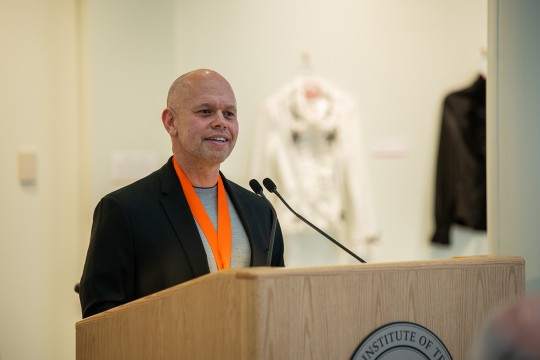
New School of Film and Animation director, faculty roles for 2025-26
Ricky Figueora taking over as the new director of RIT's School of Film and Animation headlines exciting promotions and additions to the College of Art and Design faculty.
-
September 23, 2025

RIT-created virtual reality game ‘Changeling VR’ arrives on Steam
More than 300 RIT students have published Changeling VR, a new narrative mystery game on Steam. The virtual reality (VR) game is now available to download for free on the online game platform for early access.
Contact
- Jason Arena
- Associate Professor, Art - Design and Applied Arts
- School of Design
- College of Art and Design
- 585‑475‑4542
- jxafaa@rit.edu
School of Design










